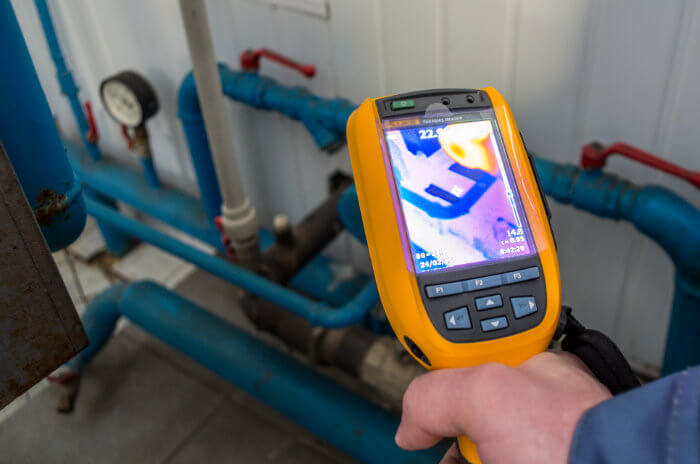Innovative Solutions for Very Early Discovery of Water Leakages in Structures and Facilities
From sophisticated leak detection innovations to the implementation of IoT sensors for real-time tracking, the landscape of leak prevention is evolving swiftly. Automated water flow analysis systems are reshaping how leaks are identified and addressed, paving the way for a positive technique to water leak detection.
Advanced Leak Detection Technologies
Advanced leakage detection modern technologies, furnished with advanced sensing units and formulas, play an essential duty in quickly recognizing and determining water leaks in different setups. Electromagnetic sensing units can identify adjustments in electromagnetic fields created by water, providing yet an additional layer of leak discovery capability.

IoT Sensors for Real-Time Monitoring
In the realm of contemporary water leakage detection, the combination of IoT sensing units for real-time monitoring represents a critical advancement in improving positive leak detection abilities. These sensing units supply constant tracking of water supply, supplying real-time data on water flow rates, pressure variations, and temperature changes. By leveraging IoT technology, these sensors can spot even the smallest anomalies in water usage patterns, allowing very early identification of prospective leaks before they intensify right into significant concerns.
IoT sensing units send information to a central platform, where advanced algorithms evaluate the info and generate alerts or notifications when abnormalities are identified. This real-time monitoring capability allows homeowner or facility supervisors to quickly address leakages, decreasing water damages, lowering fixing expenses, and conserving water resources.
Furthermore, IoT sensing units can be integrated with building monitoring systems, permitting automatic responses to detected leaks, such as turning off water shutoffs or activating pumps to minimize the influence of leaks. Overall, the execution of IoT sensors for real-time surveillance substantially improves the performance and efficiency of water leak discovery in buildings and framework.
Maker Learning Algorithms for Leakage Prediction

One key benefit of using machine learning for leak forecast is its capacity to continually discover and improve its precision in time. As even more data is gathered about his and fed into the formula, it can improve its predictions and adjust to altering problems, eventually raising the reliability of leakage detection systems.
In addition, maker learning formulas can help in determining subtle indicators of leakages that might go unnoticed by traditional tracking approaches. water leak detection. By evaluating intricate data embed in real-time, these algorithms can provide early cautions and alerts, enabling punctual intervention and precautionary upkeep to alleviate potential water damages and associated expenses
Using Thermal Imaging for Leakage Discovery
Thermal imaging innovation uses an appealing strategy for spotting water leaks in numerous systems and infrastructures. By making use of infrared radiation and temperature variances, thermal imaging cams can identify concealed leakages that are not conveniently noticeable to the naked eye. When water runs away from pipelines or structures, it typically transforms the temperature of the surrounding location, developing temperature level differentials that thermal video cameras can capture. These temperature irregularities are then translated into noticeable pictures, highlighting the specific area of the leakage.
One of the key benefits of thermal imaging for leakage discovery is its non-intrusive nature. Unlike traditional approaches that might call for burglarizing wall surfaces or floorings to find leakages, thermal imaging enables non-destructive screening. This not only conserves time and minimizes expenses however additionally lessens interruption to the building or framework being analyzed. In addition, thermal imaging can promptly check large locations, giving a comprehensive summary of prospective leak resources in a prompt manner. Overall, the usage of thermal imaging innovation enhances the performance and accuracy of water leakage detection, making it an important device for preserving the stability of buildings and facilities.
Automated Water Circulation Analysis Equipments
Exactly how can computerized water flow evaluation systems transform the detection and administration of leaks in different systems and frameworks? Automated water flow evaluation systems supply a positive technique to leak detection by continuously keeping track of water circulation rates and patterns. By establishing standard data, these systems can swiftly recognize discrepancies that may suggest a leak, allowing punctual treatment to stop comprehensive damages.
These systems make use of advanced formulas to evaluate real-time information and offer prompt alerts when abnormalities are detected, enabling speedy activity to be taken. Furthermore, computerized water circulation evaluation systems visit the site can be integrated with building management systems or IoT platforms, improving general efficiency and allowing remote tracking capacities.
In addition, the information accumulated by these systems can be made use of for anticipating maintenance objectives, aiding to recognize potential weak points in the infrastructure before leaks occur. Overall, the execution of automatic water flow analysis systems can substantially enhance leakage detection and management techniques, inevitably resulting in cost financial savings, decreased water wastefulness, and boosted sustainability in buildings and infrastructure.

Conclusion
To conclude, the assimilation of advanced leak discovery innovations, IoT sensors, artificial intelligence algorithms, thermal imaging, and computerized water flow evaluation systems uses innovative helpful site services for very early detection of water leakages in structures and facilities. These innovations allow real-time tracking, prediction of leaks, and reliable discovery approaches to avoid water damage and wastage. Implementing these solutions can help in keeping the honesty and sustainability of water systems in various settings.